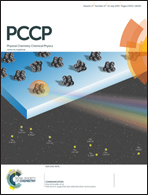Exploration of the binding interaction of a potential nervous system stimulant with calf-thymus DNA and dissociation of the drug–DNA complex by detergent sequestration
Abstract
The binding interaction of a potential nervous system stimulant, 3-acetyl-4-oxo-6,7-dihydro-12H-indolo-[2,3-a]-quinolizine (AODIQ), with calf-thymus DNA (ctDNA) has been explored thoroughly. The modified photophysics of the fluorescent molecule within the microheterogeneous biomacromolecular system has been exploited to divulge the drug–DNA binding interaction. The absorption and various fluorometric measurements together with the fluorescence quenching, urea-induced denaturation study, circular dichroism and DNA-melting studies unequivocally ascertain the mode of binding of the drug with the DNA to be groove binding. Corroborating the experimental observations, molecular docking simulation projects the minor groove of the biomacromolecule to be the site of binding. Further experiments have revealed that dissociation of the drug from the drug–DNA complex can be achieved by the detergent sequestration method. Besides providing an insight into the drug–DNA interaction the work also demonstrates the surfactant-induced excretion of the drug from the biomacromolecular assembly.


 Please wait while we load your content...
Please wait while we load your content...